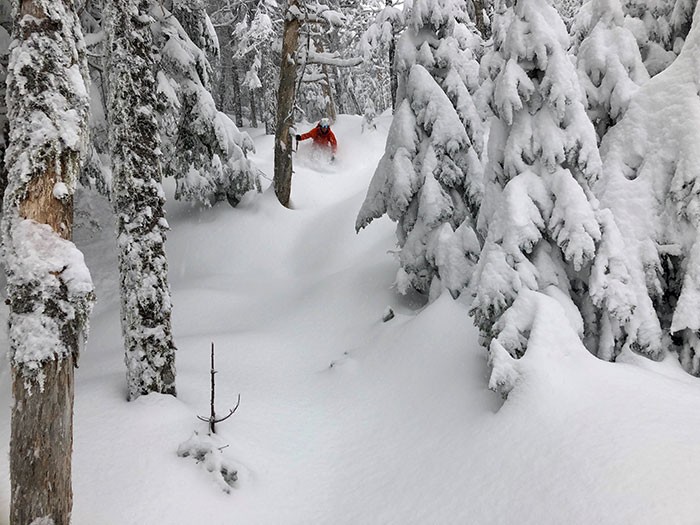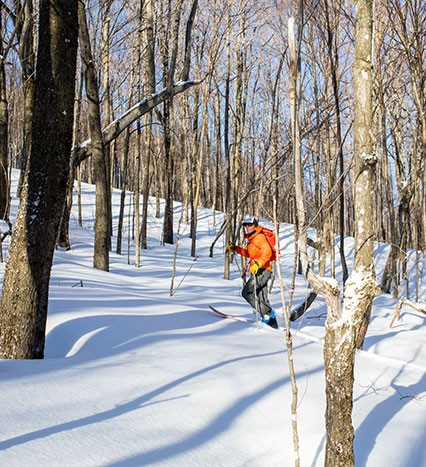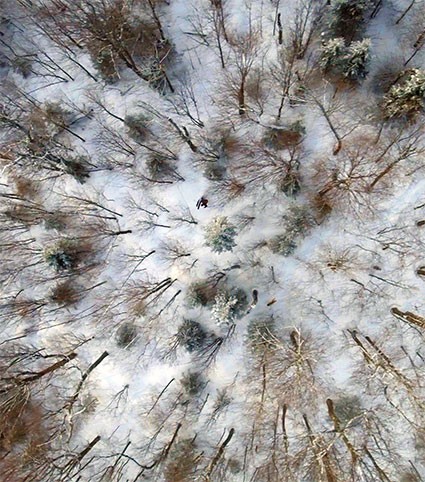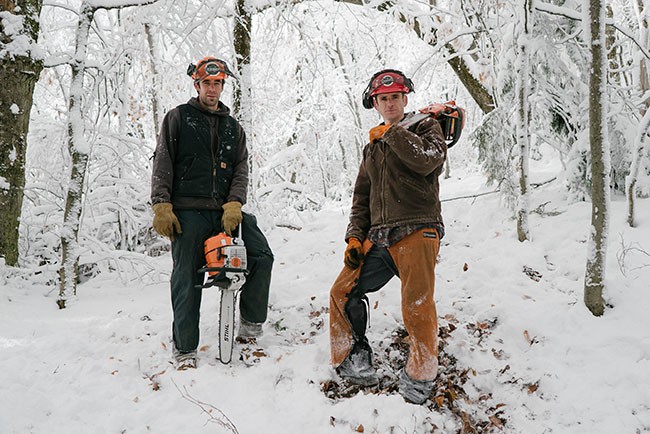Once upon a time, skiers had to hike uphill for the exhilarating reward of gliding down through the trees. The earliest ski trails in New England were cut through forests in the 1930s – well before chairlifts or tramways or T-bars were commonplace – often by the Depression-era Civilian Conservation Corps. Many of these trails were on land owned by states or the US Forest Service. Some, like the Nose Dive at Mount Mansfield in Vermont and the Taft Trail at Cannon Mountain in New Hampshire, were added to and eventually evolved into modern ski areas. As skiing developed around ski centers with high-speed lifts, groomed runs, and overpriced burgers served in heated lodges, some skiers stuck to the woods, seeking quieter outings whose only cost was climbing up to earn the thrill of sliding down. Eventually, backcountry skiers in some places clandestinely – and often illegally – took to trimming their own lines through their favorite forests. Sometimes, those lines were on private land; frequently, they were on public property.
But a new wave of backcountry skiers is coming out of the shadows to work with the US Forest Service, municipalities, states, land trusts, and private landowners to create ski runs that are fast and fun but also fit within forest management plans. They are looking to build community and collaboration, to return to skiing’s roots while forging a new backcountry path.
“Our job is to let our users know that we can do this in a different way,” said Tyler Ray, a founding member of the Granite Backcountry Alliance (GBA), a group devoted to increasing backcountry skiing opportunities that was established in 2016. “We don’t need to wear ski masks and hide behind a hacksaw. We can get the right approvals and do it out in the open.”
Ray and the volunteer crew at GBA find inspiration in some of the old CCC trails scattered throughout New Hampshire’s forests – trails that were built by local communities as a means to both enjoy the outdoors and to foster economic development by attracting the first wave of recreational skiers in the country. They’ve also been inspired by a group of backcountry skiers in Vermont called the Rochester/Randolph Area Sports Trail Alliance (RASTA), which has advocated for the development of multi-use trails in the central part of the state since 2013.
CONSERVATION AND RECREATION
RASTA’s first trail project took place on a 1,500-acre property in Braintree, Vermont. The property – now called the Braintree Mountain Forest – just happened to be a favorite backcountry stash for Zac Freeman, one of the founding members of RASTA. “I’d skied up there for years,” said Freeman, describing a high-elevation, old-growth forest with trees spaced perfectly for smooth ski turns. Paul Kendall and Sharon Rives, who donated the land to the New England Forestry Foundation (NEFF) in 2013, “love to share, and they love skiing,” Freeman said.
Kendall and Rives had been maintaining a network of cross-country skiing, biking, and hiking trails on the land for years. When the land was transferred, Freeman and RASTA approached NEFF about developing some pockets of gladed ski runs there, and a new collaboration was born.
“We were comfortable integrating recreation into our forest management plan, but this was going to be different,” said Chris Pryor, director of forest stewardship for NEFF. “A glade is a more dispersed use, covering 20 to 30 acres as it spreads through the woods. We coordinated with Paul and Sharon to make sure this was something that matched their vision for the property.”
RASTA’s glade-cutting plan meshed with NEFF’s primary goal of timber management and the maintenance of healthy wildlife habitat. The areas RASTA was keen to develop as ski glades were high-elevation and steeply sloped – and what Pryor described as “not particularly high-productive forests.” The strategy of clearing some of the understory species, which are less desirable from a timber harvest perspective, fit with NEFF’s management plan for the property.
In the fall of 2014 and the spring of 2015, RASTA hosted a couple of work days, with dozens of volunteers on hand to help thin out the understory, lop off low branches, and create skiable lines while minimizing damage to the forest. The resulting glades offer 750 to 1,000 vertical feet of backcountry skiing. This past summer, RASTA worked to finish renovating the nearby Bell Gates Cabin, a first-come, first-served backcountry hut that sleeps about eight.
Freeman said trail counters placed on the property during the winter of 2016 to 2017 indicate there were about 500 backcountry skier visits during that time. An analysis of the counters showed an average of about 7 skiers per day, with numbers reaching nearly 17 skiers on Saturdays.
One party hoping to learn from the Braintree Mountain Forest project was the US Forest Service, which had been looking for a way to stem illegal cutting while also including backcountry skiing as an allowed use on the lands it manages.
“We were seeing people cutting where they weren’t supposed to be, and there is ecological concern with that,” said Holly Knox, recreation program manager for the Rochester and Middlebury Ranger Districts in the Green Mountain National Forest (GMNF).
In an effort to guide the development of backcountry ski lines in the region, the Forest Service partnered with RASTA on a pilot project to create a backcountry ski zone at Brandon Gap in the GMNF. The goals included reducing illegal cutting and enhancing skier access while implementing sustainable vegetation-management techniques to aid the restoration of areas of the forest affected by past illegal cutting.
“Brandon Gap was selected for a lot of different reasons,” Knox said, including an existing parking area, a good slope with a primarily north-facing aspect, and routes that would guide skiers through the forest safely.
While RASTA provided the volunteers to create the backcountry zones in Brandon Gap, the Forest Service developed a plan, based on the ecology and silvicultural management of the area, for what could and could not be cut. On the list of vegetation to be cleared were hobblebush, standing dead trees posing a safety risk, and shrubs and woody vegetation greater than one meter in height. Low-hanging branches were also OK to prune. Left untouched were mountain ash, large yellow birch trees, and islands of softwoods.
The Forest Service hopes the Brandon Gap project and its partnership with RASTA will serve as a model for collaboration on similar projects in the future – that as skiers are educated about the ecological effects of unregulated cutting and see how working together benefits both forest and skiers, the partnership between skiers and conservationists will grow stronger.
“It seems like everyone is in this transition phase,” said Zac Freeman, who added that RASTA has already proposed other areas for backcountry ski zones in the GMNF. “Once a few more of these projects develop, I think it will change the game.”
A GROUP EFFORT
This model of collaboration is finding a foothold in New Hampshire, too. The Granite State is, of course, home to Mount Washington, whose Tuckerman Ravine is legendary – and very crowded, come late winter and early spring. But there’s a need for more accessible places to ski.
“We have this incredible increase in user traffic in our backcountry, but in the White Mountains and surrounding areas we are really limited in terrain options,” said Granite Backcountry Alliance’s Tyler Ray. “People’s first introduction to backcountry skiing is often hiking up a 50-degree face and ragdolling down.”
In an effort to develop other backcountry options, including more easily accessible below-treeline ski zones, the GBA worked in its inaugural year to improve access trails and develop new terrain. It also successfully worked through the permitting process with the US Forest Service to develop new areas like Brandon Gap in the White Mountain National Forest, where zones on Bartlett Mountain and Baldface Mountain will be ready to ski – the snow gods willing – this winter.
On Bartlett Mountain, near the bustling ski town of North Conway, GBA has reclaimed and expanded the Maple Villa Ski Trail, cut in the 1930s by the Civilian Conservation Corps. The old trail will serve mainly as an uphill skin track, with glades flowing in and out of that path.
Near the border with Maine, South Baldface, in Evans Notch, New Hampshire, is more remote. Eighty people showed up there for a trail-work day in September, working under USFS guidelines to create a gladed ski zone. Tyler Ray said the area offers something for just about every type of backcountry skier, with the bottom half of the trail comprising gentler terrain and the upper reaches providing steeps, and with an impressive vertical drop around 2,500 feet from top to bottom.
As in Vermont, collaboration is a key part of the “human-powered” ski movement in New Hampshire. In Bartlett, the group worked with six different landowners – including the town of Bartlett, the USFS, and several land conservation groups – to develop a plan and inform local residents.
With the new tagline Glade in My Backyard – or GIMBY – GBA has also put considerable emphasis on developing backcountry ski options in collaboration with private and municipal landowners, areas where local skiers can get out and make some runs without having to trek too far from home.
“Not everybody has 10 hours where they can go on a giant ski tour. Sometimes you only have 90 minutes,” said Ray. “We’re looking to really create that network where you can have a big day in the Whites or you can have a lunch-break tour.”
In August 2017, GBA held a work day at the Randolph Community Forest in New Hampshire. They’d worked with the town’s forestry commission to develop a plan, hired a glade designer, and met with the town forester. More than 70 volunteers showed up for a work day in a forest owned by a town whose population is just over 300 people. At the end of it all, there were five ski lines cut into a 75-acre glade in the shadow of the lofty Presidential Mountains.
GBA is working with other municipalities, local land trusts, and private property owners around the White Mountains to create additional backcountry options – both for the skiers who live nearby and for others drawn to the area by its outdoor recreational opportunities, much like the skiers of the 1930s.
“I really see this as creating communities and creating opportunities to ski in a different way,” Ray said. “We’re really looking to get communities, particularly in the North Country, to engage with the locals; create something that’s going to benefit the community and drive economic activity.”
Freeman, Ray, and their skiing cohorts hope to build on their early successful collaborations to protect both the forests and the sweet ski lines within.
“For me and a lot of my friends, it’s about the peace and quietness. You’re away from crowds. There’s a huge exercise aspect to it that we love. But really, to be out in the woods,” said Freeman. “There’s no lifts. There’s no structure. To just be out there with a small group of friends. It’s a great way to spend time.”
For information on RASTA projects and backcountry ski zones, visit their website. The new Chittenden Brook Hut, built by the Yestermorrow Design/Build School, is expected to open this year near the Brandon Gap glades. Reservations are required. For more information on GBA projects, membership, and work days, visit this link.





